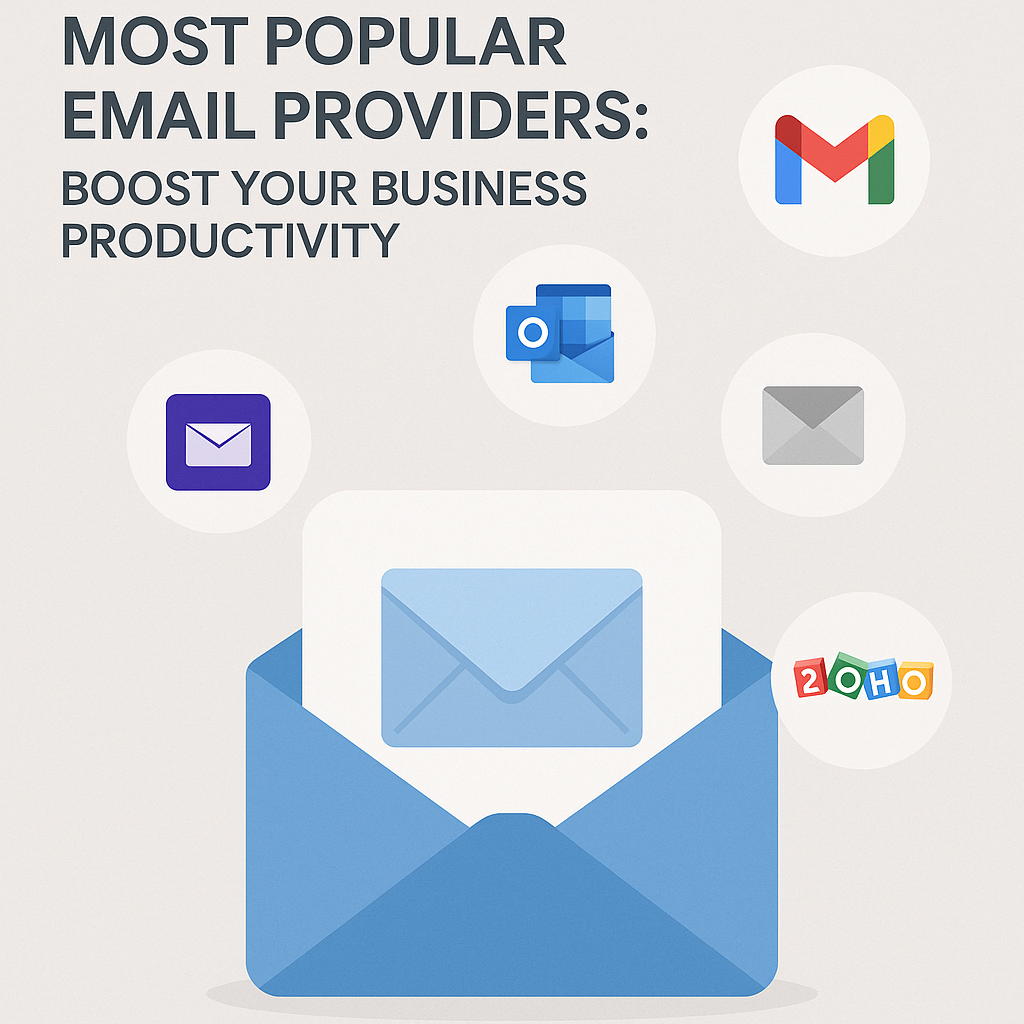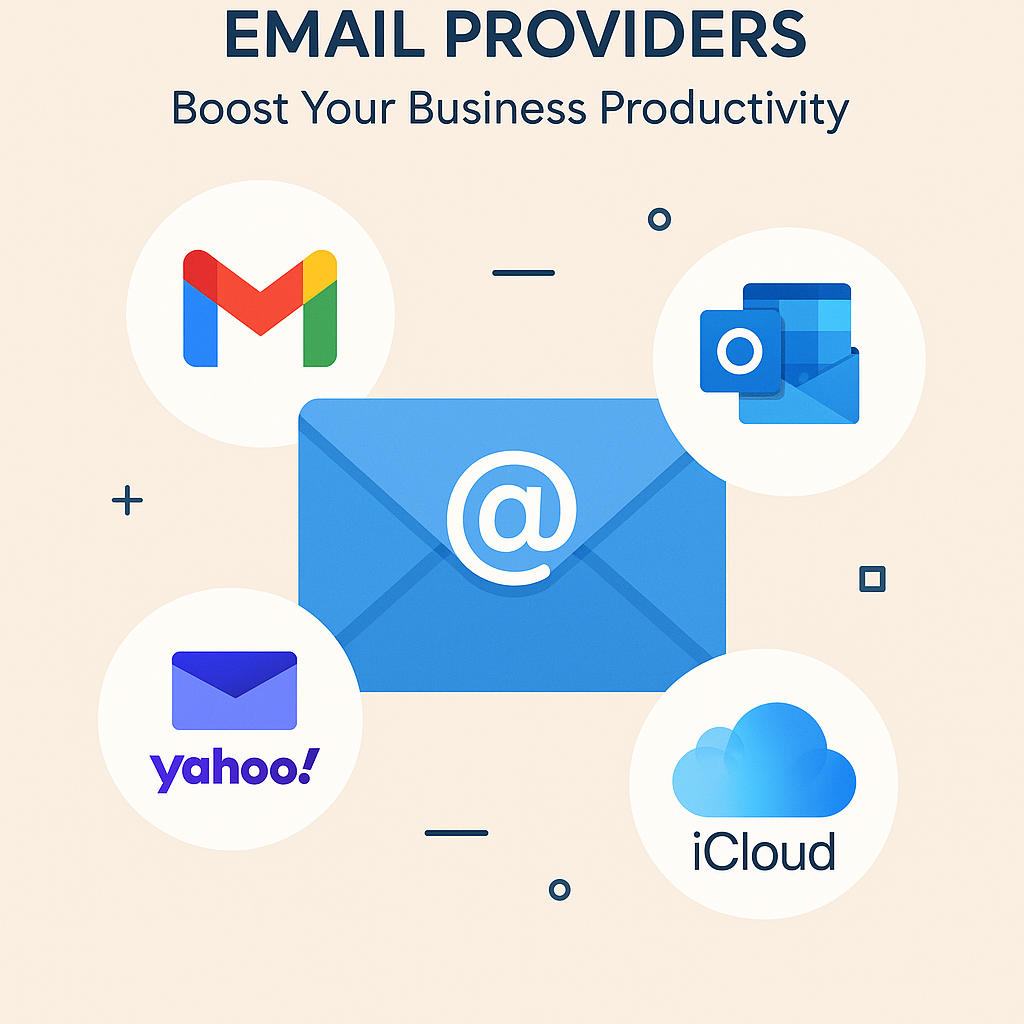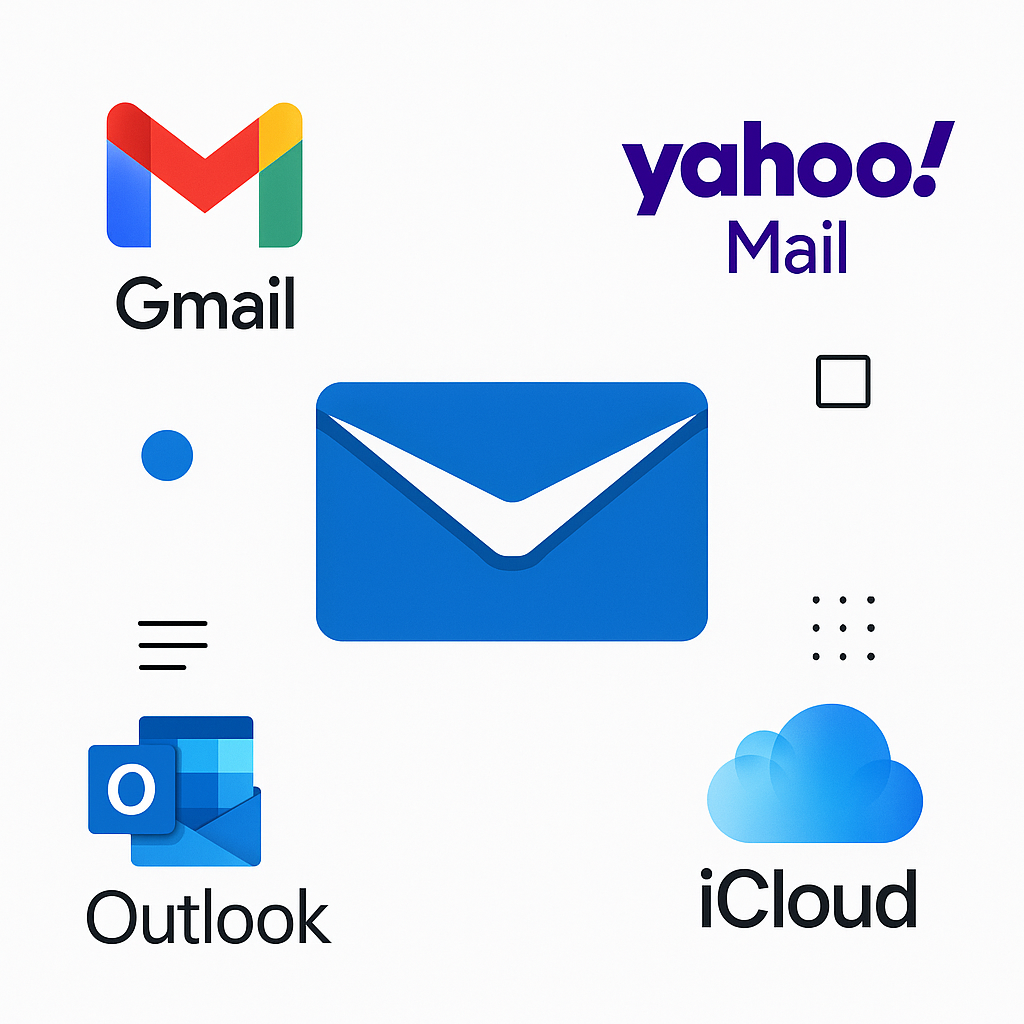Most Popular Email Providers: Boost Your Business Productivity

In today's fast-paced business world, email remains the cornerstone of communication, project management, and client relations. Yet, for many, it's also a significant drain on productivity. The sheer volume of messages, the constant need to switch contexts, and the struggle to keep inboxes organized can feel like an uphill battle. Choosing the right email provider isn't just about sending and receiving messages; it's about selecting a platform that actively supports and enhances your professional workflow. From seamless collaboration to robust task management and integration with your favorite business tools, your email service can make or break your efficiency.
This article will explore the most popular email providers used by businesses today, dissecting their features, strengths, and weaknesses with a keen eye on how they impact productivity. Whether you're a seasoned executive, a burgeoning entrepreneur, a busy sales professional, or a remote worker navigating distributed teams, understanding these platforms is key to optimizing your daily operations. We'll delve into giants like Gmail and Outlook, examine the comprehensive offerings of Zoho Mail, and touch upon other notable players. Furthermore, we'll provide actionable strategies to maximize productivity with your current setup and look ahead to how advanced technologies are revolutionizing email management for even greater efficiency.
Gmail for Business: Familiarity Meets Powerful Integration
When discussing the most popular email providers, Gmail is almost invariably at the top of the list. Its consumer-grade interface is incredibly familiar to billions worldwide, making the transition to Google Workspace (formerly G Suite) for business use a relatively smooth one for many organizations. Google Workspace offers a robust suite of integrated tools designed to boost productivity and collaboration.
Key Features for Business Productivity:
- Generous Storage: Business accounts typically start with 30GB of storage per user, expandable through Google Drive, offering ample space for emails, documents, and files.
- Powerful Search: Gmail's search functionality is legendary, allowing users to quickly find any email, attachment, or contact with precise search operators.
- Integrated Collaboration Tools: Seamless integration with Google Meet for video conferencing, Google Chat for instant messaging, and Google Calendar for scheduling keeps communication and planning centralized.
- Google Workspace Ecosystem: Beyond email, users gain access to Google Docs, Sheets, Slides, Forms, and more, fostering a collaborative environment where documents can be created, shared, and edited in real-time.
- Custom Domain Email: Business users can use their own domain name (e.g., [email protected]) for a professional online presence.
Pros for Professionals:
- User-Friendly Interface: Its intuitive design and familiar layout reduce the learning curve, allowing users to get up and running quickly.
- Exceptional Search Capabilities: Finding information is incredibly fast and efficient, saving valuable time.
- Strong Collaboration Features: The tight integration with other Google Workspace apps makes team collaboration seamless.
- Vast Third-Party Integrations: A huge marketplace of add-ons and integrations connects Gmail with CRMs, project management tools, and other essential business applications.
Cons for Professionals:
- Potential for Inbox Overload: While powerful, the sheer volume of features and notifications can contribute to inbox clutter if not managed effectively. Learning advanced Gmail inbox cleanup techniques is often necessary.
- Privacy Perceptions: Despite Google's assurances, some businesses remain concerned about data privacy and how Google uses data within its ecosystem.
- Advanced Organization: For highly complex email management needs, users might find themselves needing third-party tools or developing intricate filter systems.
With over 1.2 billion users globally, Gmail's widespread adoption is a testament to its usability and feature set. For businesses already invested in the Google ecosystem, it's an indispensable tool for daily operations. However, mastering its potential requires proactive email management tips.
Microsoft Outlook: Deep Dive into Business Features and Productivity Integration
Microsoft Outlook, particularly as part of the Microsoft 365 suite, is another titan among the most popular email providers for businesses. It’s renowned for its robust feature set, especially for users deeply embedded in the Windows and Microsoft Office ecosystem. Outlook offers a comprehensive approach to managing not just emails, but also schedules, contacts, and tasks.
Key Features for Business Productivity:
- Integrated Calendar and Task Management: Outlook's strength lies in its seamless integration of email, calendar, contacts, and tasks within a single application. This allows for efficient scheduling, appointment setting, and to-do list management directly from your inbox.
- Advanced Rules and Filtering: Users can create sophisticated rules to automatically sort incoming mail, assign categories, flag messages, and even trigger actions, significantly reducing manual sorting.
- Microsoft 365 Ecosystem Synergy: For businesses using Microsoft 365, Outlook integrates flawlessly with Teams for communication, OneDrive for cloud storage, SharePoint for document management, and other Office applications like Word and Excel.
- Powerful Desktop Client: The Outlook desktop application is feature-rich, offering offline access, advanced customization options, and a high degree of control over email management.
- Custom Domain Email: Like Gmail, Outlook for Business (via Microsoft 365) allows the use of custom domain email addresses.
Pros for Professionals:
- Comprehensive PIM (Personal Information Management): Its all-in-one approach to managing email, calendar, and tasks is unparalleled for many professionals.
- Strong for Enterprise and Windows Users: It’s the de facto standard in many corporate environments and offers deep integration with Windows operating systems.
- Robust Security and Compliance: Microsoft 365 offers strong security features, including advanced threat protection and data loss prevention, crucial for many industries.
- Offline Capabilities: The desktop client allows full functionality even without an internet connection, syncing changes once connectivity is restored.
Cons for Professionals:
- Steeper Learning Curve: The sheer number of features and customization options can make Outlook feel complex and overwhelming for new users.
- Web Version Limitations: While functional, the Outlook web app doesn’t offer the full depth of features found in the desktop client.
- Resource Intensive: The desktop application can be resource-heavy, potentially impacting performance on older or less powerful machines.
- Licensing Costs: While there's a free web version, the full-featured business experience requires a Microsoft 365 subscription.
For professionals who rely heavily on detailed scheduling, task delegation, and integration with other Microsoft productivity tools, Outlook remains a premier choice. Mastering its advanced rules and calendar features can dramatically help reclaim email time.
Zoho Mail: A Comprehensive Solution for Growing Businesses
Zoho Mail positions itself as a business-centric email solution that’s part of a much larger, integrated suite of business applications. It’s particularly attractive to small and medium-sized businesses (SMBs) and startups looking for a cost-effective yet feature-rich platform that can scale with their growth. Zoho Mail focuses on providing a clutter-free experience and essential business tools without the overwhelming complexity or price tag of some larger competitors.
Key Features for Business Productivity:
- Custom Domain Email: Essential for professional branding, Zoho Mail supports custom domain email addresses.
- Integrated Business Apps: Beyond email, Zoho Mail users gain access to Zoho Calendar, Contacts, Tasks, Notes, and a suite of other business applications like Zoho CRM, Projects, and Docs. This creates a unified workspace.
- Clean and Intuitive Interface: Zoho Mail is designed with a focus on simplicity and ease of use, aiming to reduce inbox clutter and streamline daily workflows.
- Collaboration Tools: Features like shared mailboxes, team chat integration (via Zoho Cliq), and collaborative document editing enhance team productivity.
- Affordable Pricing: Zoho Mail offers competitive pricing, with generous free tiers for basic needs and affordable paid plans that include more storage and advanced features.
Pros for Professionals:
- All-in-One Business Suite: The integration of email with CRM, project management, and other tools provides a cohesive business environment.
- Excellent Value for Money: It offers a comprehensive feature set at a price point that is highly attractive to SMBs.
- Focus on Privacy: Zoho emphasizes user privacy and does not display ads or track users for advertising purposes in its business offerings.
- Customization and Automation: Features like custom filters, templates, and email routing rules help automate repetitive tasks.
Cons for Professionals:
- Ecosystem Size: While growing, the Zoho ecosystem isn't as vast or as widely adopted as Google Workspace or Microsoft 365, meaning fewer third-party integrations might be available.
- User Interface Learning Curve: While generally intuitive, navigating the broader Zoho suite might require some initial adjustment for users accustomed to simpler email clients.
- Less Brand Recognition: Compared to Gmail or Outlook, Zoho might have less brand recognition among the general public, though it's highly respected in business circles.
For businesses seeking a powerful, integrated suite of tools that includes email as a central component, Zoho Mail’s features make it a compelling choice. Its focus on providing a holistic business solution at an accessible price point makes it a standout among the most popular email providers for growing companies.
Other Popular Business Email Providers: A Quick Overview
While Gmail, Outlook, and Zoho Mail dominate much of the business email landscape, several other providers cater to specific needs, particularly regarding security, privacy, or simplicity. Understanding these alternatives can help you choose the best email for business that aligns with your unique requirements.
- ProtonMail: Renowned for its end-to-end encryption and strong commitment to privacy, ProtonMail is an excellent choice for individuals and organizations that handle highly sensitive information. Its Swiss-based servers and zero-access encryption mean even ProtonMail cannot read your emails. While it may lack some of the deep integration features of larger suites, its security focus is unparalleled.
- Fastmail: This provider emphasizes speed, simplicity, and user control. Fastmail offers a clean, fast interface, robust search, custom domain support, and excellent integration with third-party email clients. It’s a favorite among power users who appreciate a no-nonsense, reliable email service without the extensive add-on features that can sometimes lead to complexity.
- iCloud Mail: Primarily for Apple users, iCloud Mail offers seamless integration across Apple devices and a clean, user-friendly interface. While functional for basic business needs, its collaboration and integration capabilities are generally less robust than dedicated business suites like Google Workspace or Microsoft 365.
- Yahoo Mail: Historically a popular free email service, Yahoo Mail still offers substantial free storage (up to 1TB). However, its business-oriented features and integrations are less developed compared to the leading providers, making it more suitable for personal use or very small, informal business operations.
- GMX Mail: Similar to Yahoo Mail, GMX offers free email accounts with large storage capacities and basic features. It's generally considered a functional option for personal use or simple business communication but lacks the advanced tools and integrations needed for serious business productivity.
Each of these providers offers a different value proposition. ProtonMail prioritizes security, Fastmail champions speed and simplicity, while iCloud, Yahoo, and GMX cater more broadly to general users, though they can serve basic business needs.
Evaluating Email Providers Based on Productivity Needs
Choosing the right email provider is a strategic decision that can significantly impact your business's efficiency. When evaluating options beyond the most popular email providers, consider these key productivity-centric factors:
1. Collaboration Features:
- Team Communication: Does the provider integrate seamlessly with team chat applications (like Slack, Microsoft Teams, Google Chat) and video conferencing tools?
- Shared Mailboxes/Calendars: Can teams share inboxes for customer support or sales inquiries? Are shared calendars easy to manage for team scheduling?
- Document Sharing and Co-editing: How well does it integrate with cloud storage and document collaboration tools? This is crucial for teams working on shared projects.
2. Security and Reliability:
- Encryption: Does it offer end-to-end encryption or transport layer security (TLS) for emails in transit and at rest?
- Two-Factor Authentication (2FA): Is 2FA readily available and easy to implement for enhanced account security?
- Spam and Malware Protection: How effective are its filters in protecting your inbox from unwanted or malicious content?
- Uptime Guarantee: For critical business operations, a provider with a strong uptime guarantee (e.g., 99.9% or higher) is essential.
3. Integrations with Productivity Tools:
- CRM Integration: Can your email client connect with your Customer Relationship Management (CRM) software to log emails, track customer interactions, and manage leads?
- Project Management Tools: Does it integrate with tools like Asana, Trello, or Monday.com to turn emails into tasks or project updates?
- Automation and Third-Party Apps: Does the platform support Zapier, IFTTT, or have its own automation capabilities to connect with a wider range of business applications?
4. User Interface and Experience (UI/UX):
- Ease of Use: Is the interface intuitive and easy to navigate?
- Customization: Can you customize views, set up rules, and personalize the experience to match your workflow?
- Search Functionality: How powerful and fast is the search? Can it handle complex queries?
5. Scalability and Cost:
- Pricing Tiers: Are there flexible plans that can accommodate your current needs and allow for growth?
- Storage Limits: How much storage is provided per user, and how easily can it be expanded?
- Feature Progression: Do higher-tier plans offer significant productivity boosts that justify the cost?
By carefully evaluating these aspects, you can ensure your chosen email provider not only facilitates communication but actively contributes to overall workflow optimization and business success.
How to Maximize Productivity with Your Current Email Provider
Regardless of which of the most popular email providers you use, there are universal strategies to significantly boost your email productivity. Often, the platform itself is less of a bottleneck than how we utilize it. Implementing these habits can transform your inbox from a source of stress into a well-oiled machine.
- Master Your Inbox Management:
- Implement Filters and Rules: Automatically sort incoming mail based on sender, subject, or keywords. This keeps your primary inbox clean and prioritized.
- Use Labels/Folders Effectively: Categorize emails for easy retrieval. Avoid creating too many nested folders, which can become cumbersome.
- Archive Ruthlessly: Once an email is dealt with or no longer needs immediate action, archive it. Most search functions can find archived messages quickly, keeping your active inbox lean.
- Unsubscribe Aggressively: Regularly unsubscribe from newsletters and promotional emails you no longer read. Tools like unroll.me or built-in unsubscribe links can help.
- Turn Emails into Tasks:
- Most email clients allow you to convert an email into a task or a calendar event. Do this immediately for any email that requires a follow-up action or a specific time commitment.
- Utilize flagging features or create dedicated "Action Needed" folders/labels.
- Leverage Keyboard Shortcuts:
- Most email platforms offer keyboard shortcuts for common actions like replying, forwarding, archiving, and deleting. Learning these can save considerable time over the long run.
- Utilize Templates and Canned Responses:
- For frequently asked questions or common replies, create email templates. This ensures consistency and saves you from typing the same message repeatedly.
- Become a Search Power User:
- Learn your email provider’s search operators (e.g., `from:`, `to:`, `subject:`, `has:attachment`, `is:unread`). This is often faster than manually browsing through folders.
- Schedule Email Sending:
- If your provider supports it, schedule emails to be sent at specific times. This can help manage expectations, ensure messages arrive when they're most likely to be read, and maintain a consistent communication schedule.
- Batch Your Email Processing:
- Instead of checking email every few minutes, allocate specific times during the day for processing your inbox. This prevents constant context switching and allows for deeper focus on other tasks.
By adopting these email management tips, you can significantly improve your efficiency and reduce the time spent on email-related tasks, helping you reclaim email time and focus on higher-value activities.
Conclusion: Enhancing Your Email Workflow with AI-Powered Tools
Choosing the right email provider is a critical first step toward a more productive professional life. Whether you opt for the ubiquitous familiarity of Gmail, the integrated power of Outlook, the comprehensive suite of Zoho Mail, or another specialized service, understanding its capabilities and aligning them with your business needs is paramount. However, even the most feature-rich platforms can still leave room for improvement, especially when faced with the relentless tide of digital communication.
As email platforms evolve, so too must our approach to managing them. This is where artificial intelligence is making a profound impact. Tools like an ai executive assistant can help streamline your workflow by automating repetitive tasks, summarizing lengthy threads, prioritizing your inbox based on urgency and sender importance, and even drafting responses. These intelligent solutions can transform even the most popular email providers into even more powerful productivity hubs, tackling common pain points like inbox overload, task management, and communication efficiency head-on.
By combining a well-chosen email provider with smart management strategies and the power of modern AI tools, you can create a highly efficient email ecosystem. Take the time to evaluate your current setup, implement productivity-boosting habits, and explore how AI-powered solutions can further enhance your ability to communicate effectively, manage your time wisely, and drive your business forward.
```


